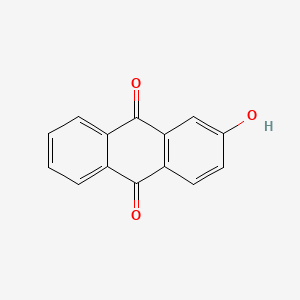Compound
D0673 | 2-hydroxyanthraquinone
| Toxicity | Dose | Time | Species | Model | Method | Action | Positive criterion | Reference |
|---|---|---|---|---|---|---|---|---|
| MEMBRANE POTENTIAL | 3.31±1.38 | human | qHTS-HepG2 | MMP assay | decrease | IC50 | 163 | |
| MEMBRANE POTENTIAL | 7.08 | human | HepG2 | MMP assay | decrease | IC50 | 163 | |
| MEMBRANE POTENTIAL | 17.28±6.83 | rat | hepatocytes | MMP assay | decrease | IC50 | 163 | |
| Pictogram | Signal | Statements | Precautionary Statement Codes |
|---|---|---|---|
  |
Warning |
Aggregated GHS information provided by 48 companies from 3 notifications to the ECHA C&L Inventory. Each notification may be associated with multiple companies. H317 (18.75%): May cause an allergic skin reaction [Warning Sensitization, Skin] H319 (20.83%): Causes serious eye irritation [Warning Serious eye damage/eye irritation] H411 (79.17%): Toxic to aquatic life with long lasting effects [Hazardous to the aquatic environment, long-term hazard] Information may vary between notifications depending on impurities, additives, and other factors. The percentage value in parenthesis indicates the notified classification ratio from companies that provide hazard codes. Only hazard codes with percentage values above 10% are shown. |
P261, P264, P272, P273, P280, P302+P352, P305+P351+P338, P321, P333+P313, P337+P313, P363, P391, and P501; (The corresponding statement to each P-code can be found at the GHS Classification page.) |
| .beta.-Hydroxyanthraquinone | 10-hydroxy-2,9-anthra-quinone | 2-HYDROXYANTHRAQUINONE |
| 2-Hydroxy-9,10-anthracenedione | 2-Hydroxy-9,10-anthraquinone | 2-Hydroxyanthra-9,10-quinone |
| 2-Hydroxyanthra-9,10-quinone # | 2-Hydroxyanthraquinone (2-Hydroxy-9,10-anthracenedione) | 2-hydroxy-anthraquinone |
| 2-hydroxyanthracene-9,10-dione | 2-hydroxyanthrachinon | 2-hydroxyanthraquinone, AldrichCPR |
| 27938-76-7 | 2R8351U6Q0 | 605-32-3 |
| 9, 2-hydroxy- | 9,10-Anthracenedione, 2-hydroxy- | 9,10-Anthracenedione,2-hydroxy |
| ACMC-1BI00 | AK307473 | AKOS001588311 |
| ANW-33517 | Anthraquinone, 2-hydroxy- | BCP24349 |
| BDBM50025601 | C-12635 | CAS-605-32-3 |
| CC-10968 | CCRIS 9186 | CHEBI:37482 |
| CHEMBL446963 | CTK3J2735 | DB-053640 |
| DSSTox_CID_29283 | DSSTox_GSID_49327 | DSSTox_RID_83402 |
| DTXSID4049327 | EINECS 210-085-8 | EU-0033611 |
| FT-0612578 | GCDBEYOJCZLKMC-UHFFFAOYSA-N | HYDROXY-9,10-ANTHRACENEDIONE |
| InChI=1/C14H8O3/c15-8-5-6-11-12(7-8)14(17)10-4-2-1-3-9(10)13(11)16/h1-7,15; | KS-000016Y5 | LS-20687 |
| MCULE-1316158292 | NCGC00260447-01 | NSC 2595 |
| NSC-2595 | NSC2595 | Q27117163 |
| RTR-020893 | SCHEMBL498619 | TR-020893 |
| TRA0059696 | Tox21_202901 | UNII-2R8351U6Q0 |
| W-109568 | ZINC3896782 | ZX-AT027989 |
| beta-Hydroxyanthraquinone |

